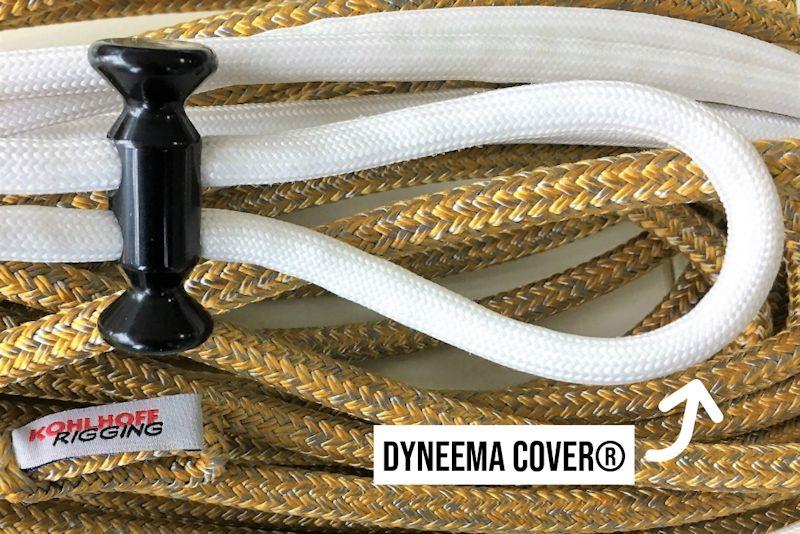
Dyneema Braided Cover - The Latest Addition to Your Tool Kit
by Kerri Robson 8 Apr 2019 09:00 BST

Dyneema Cover in use © Kohlhoff
Dyneema® is the strongest fibre in the world. Ten times stronger than steel, and seven to ten times lighter than a steel wire of equivalent size, Dyneema® is one of the most durable and sought-after materials on the sailing market.
No stranger to the benefits of Dyneema®, we have covered its various uses in previous blogs (see would you trust Dyneema® with your lifelines?). However in a first for upffront.com we are now stocking specialist Dyneema® covers online!
Although professional riggers tend to have heaps of Dyneema® braided cover lying around, the average sailor does not.
This is largely because it can be hard to get your hands on... Yet, at upffront.com we recognise that Dyneema® cover (i.e. the cover of a rope without a core!) is extremely useful for a variety of purposes on your boat's running rigging, and a perfect addition to your onboard tool kit.
Dyneema® has a multitude of benefits
It is:
- Extremely abrasion resistant
- Low friction (slippy)
- Lightweight
- Extremely UV resistant
Spliced as an extra cover on ropes, these properties make it useful for a host of applications onboard, for example:
- Chafe protection on lines Protect rope eyes, rope splices and other exposed parts of ropes
- Making your own loops and strops Use a cover to hold together multiple rounds of 1.5mm Dyneema®
- Increasing line durability E.g. around lead blocks, sheet exits, and halyard exits
- Reducing diameter of the original cover Original covers on ropes are not generally manufactured from pure Dyneema® and, as a result, are often thicker and designed for grip. Instead, Dyneema® is thinner, sleek and reduces friction on the running section of lines
- Protecting the core from UV damage
- Extending the life of a line E.g. If the cover of your halyard is chafed and worn but the core remains intact, it is possible to simply strip the damaged cover and re-cover it. If it is just the halyard exit, for example, that has been damaged, it is possible to replace just this part of the cover
The other reason covers are not more commonly used is that there are a large variety available and unless you are a professional rigger, the options and nomenclature can seem complicated.
For example, let's take the Gottifredi Maffioli range
Gottifredi Maffioli's extensive range of covers are identifiable by a 7-digit code and available in black or white.
Let's take for example their code 2x1x48L:
- 2 - The first digit refers to the number of threads that sit side by side in the braid
- 1 - The second number refers to the number of twisted yarns that each of the threads is comprised of
- So, for this example, the Dyneema® cover is comprised of 2 threads side by side, with each thread composed of 1 twisted yarn
- The larger the number of threads and yarns, the more heavy-duty the Dyneema® cover is and the greater the abrasion resistance they provide
- 48 The third number refers to the number of spools/carriers in the braiding machine
- This can be 16, 24, 32 or 48
- More carriers are required to achieve an even coverage on bigger diameter braids
- L The last letter refers to the braiding angle. A braiding angle can either be:
- L A longer braiding angle. Yarns are aligned more longitudinally than transversely, and the cover is therefore able to cover a bigger range of core diameters
- M A shorter braiding angle suitable for a smaller range of core diameters
3x3x32 XL versus 2x3x32 XL Comparison (three threads versus two threads). All threads have three yarns and are thus all the same size.
To put things into perspective, we divided the Gottifredi Maffioli range into lightweight covers with x1 yarn (e.g. 1x1x32M with a thickness of 0,7mm) versus heavy duty covers with x2 yarns (e.g. 1x2x32M with a thickness of 1,2mm). We sell a lot of 1x1x32M up to 1x1x48L which are the most common lightweight Dyneema® covers for recovering halyards on boats between 30 and 50ft.
Robline
Robline are a very big rope manufacturer with a truly global reach and they have distilled all their knowledge and experience down into a small, simple range of just three Dyneema® Cover sizes, for cores from 5 15mm.
Confused?
Don't fret! To make choosing the correct Dyneema® Cover easier, we have designed a selection guide to help you make the right choice.
Explore our entire Dyneema® Cover range here.